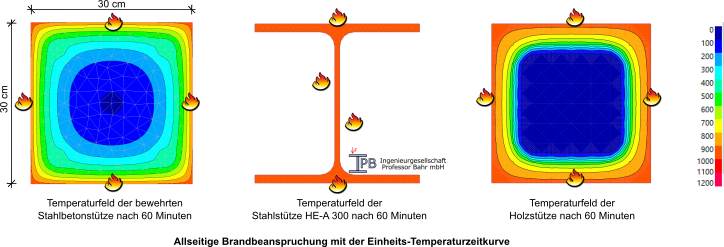Influence of the material selection on the constructive fire protection
Why is material selection important?
Structures must be designed to be fireproof. This means that members must withstand for a specific time (the so-called fire resistance period) temperatures from the ISO standard fire. Various materials are available in construction, the three most important being steel, reinforced concrete and wood. Due to their different microstructure, the materials behave very differently (e.g. steel and concrete do not burn, while wood forms a pyrolysis layer), so material selection is important.

Comparison of heating of steel, reinforced concrete and wood in case of fire
In principle, constructive fire protection can be ensured with all three materials. However, the steel usually has to be protected against fire (e.g. with gypsum boards or intumescent coatings), while reinforced concrete, for example, usually meets the fire safety requirements without further measures.
In the event of a fire, the three materials not only differ in terms of how they heat up, but also in terms of their material properties (strength and rigidity). At this point, only the different heating of the three materials should be discussed. In terms of a qualitative study, three cross-sections made of steel, reinforced concrete and wood are heated according to the ISO standard fire. The temperature fields of the cross-sections are then compared .
The figure above shows the temperature fields for a square reinforced concrete column with a width/height of 30 cm, a wooden column with identical dimensions and a steel profile HE-A 300 after 60 minutes of fire exposure from all sides according to ISO standard fire. The steel profile has a maximum temperature of approx. 940°C, which would lead to significant degradation of material properties and failure in the event of a fire. In this respect it is clear that unprotected steel constructions in buildings with fire protection requirements are rarely or never seen.
In contrast, the reinforced concrete column and the wooden column heat up much more slowly. What is striking is the inhomogeneous temperature field in each case, in which the inner zones still have a high load-bearing capacity. Both building materials benefit from their low thermal conductivity and thus offer inherent structural fire protection.
Proof of structural fire protection
For your project, I can economically dimension all three materials (and others, such as e.g. steel composite) with the help of a fire design. In the case of new properties to be built, it is highly recommended that you involve me in the planning phase. In the case of unprotected steel structures in particular, the fire design is often decisive for the choice of profile. In this respect, the planning and production effort can be significantly reduced if contact is made at an early stage.
Non-binding initial consultation
It would be best if you call me directly now and describe your specific task to me. Or you can send me an e-mail with your project data. Floor plans, views and sections of the respective construction project are helpful, which I will of course treat confidentially. If available, a fire protection concept is also helpful. On this basis we can discuss the general conditions and I can make you an attractive offer.